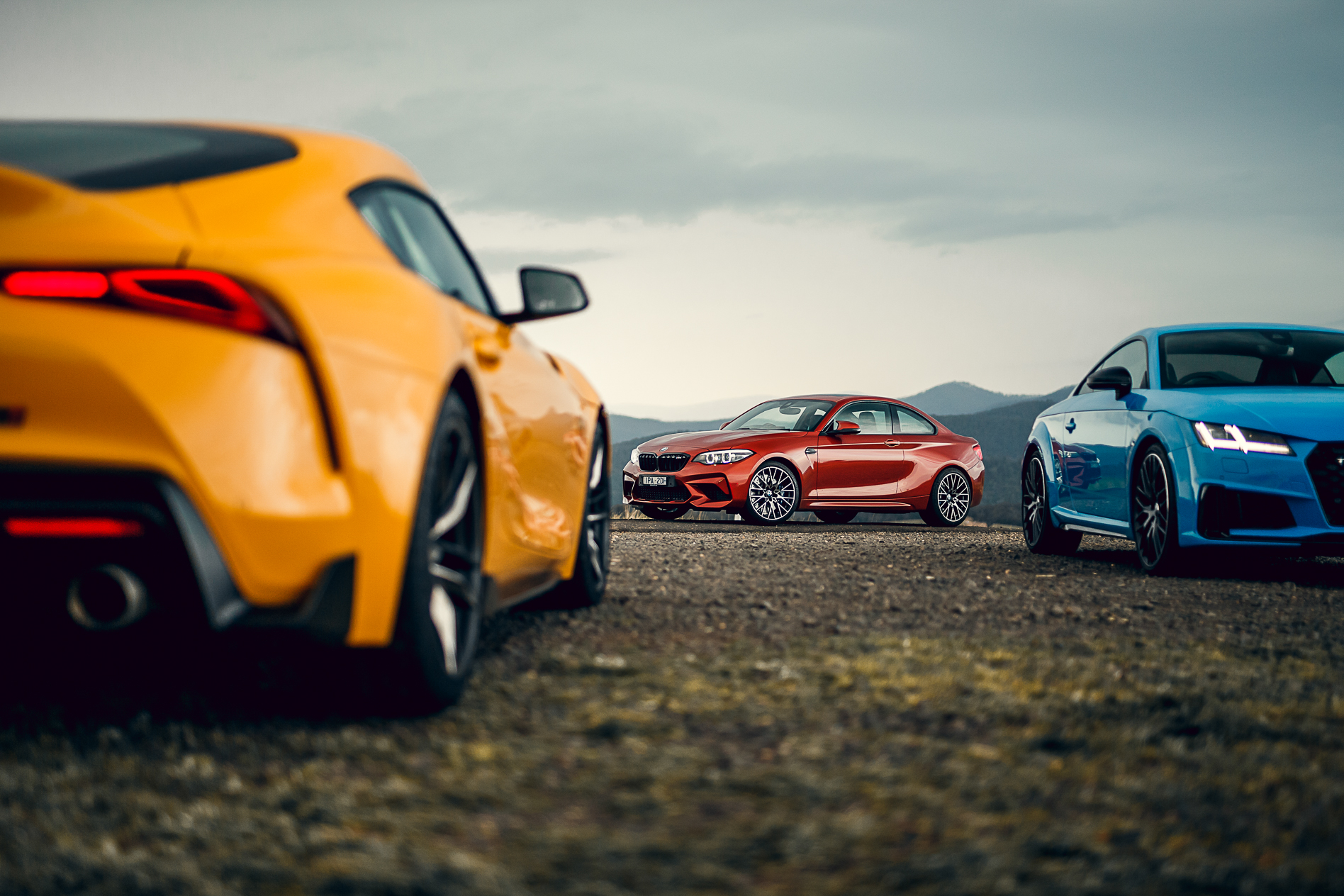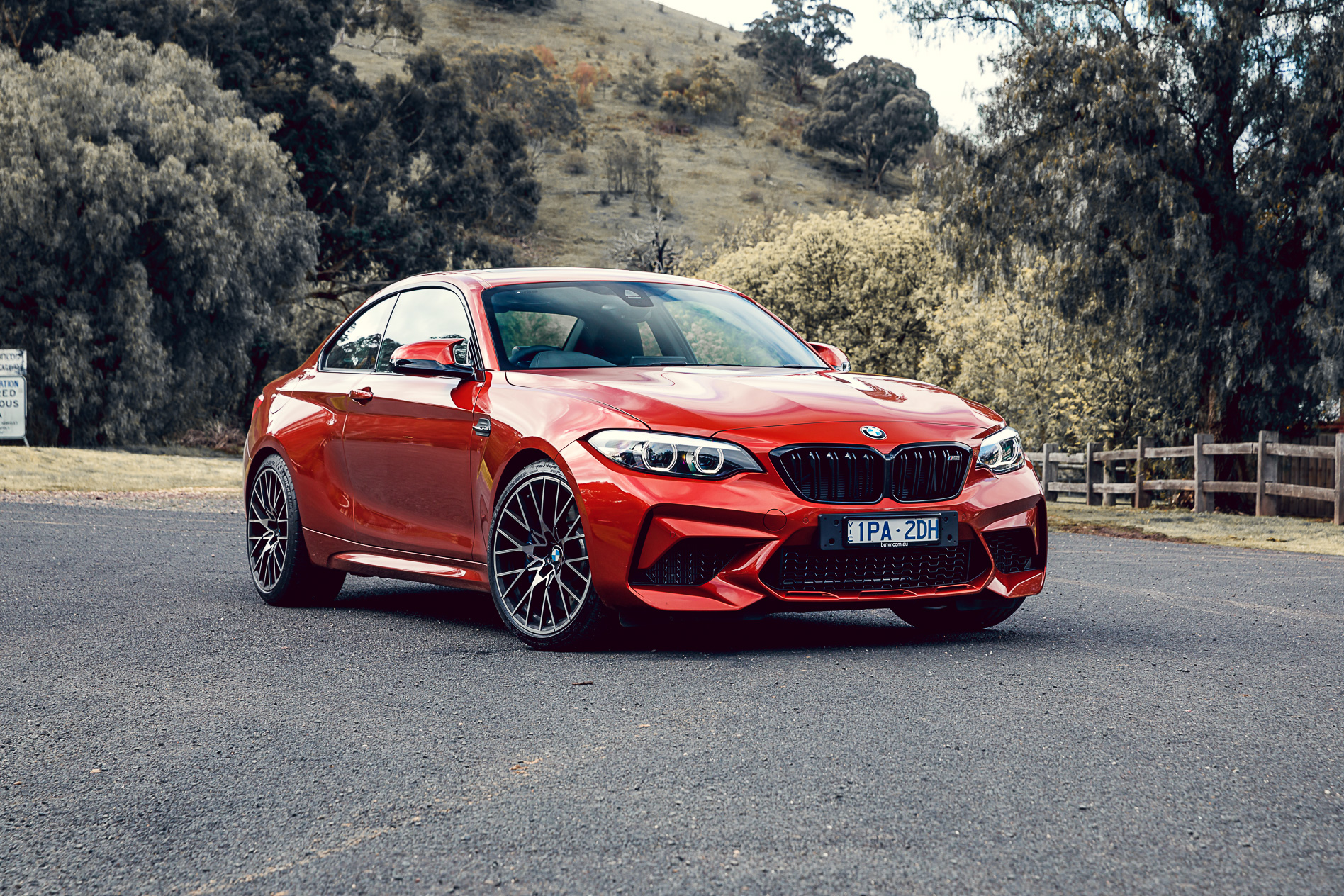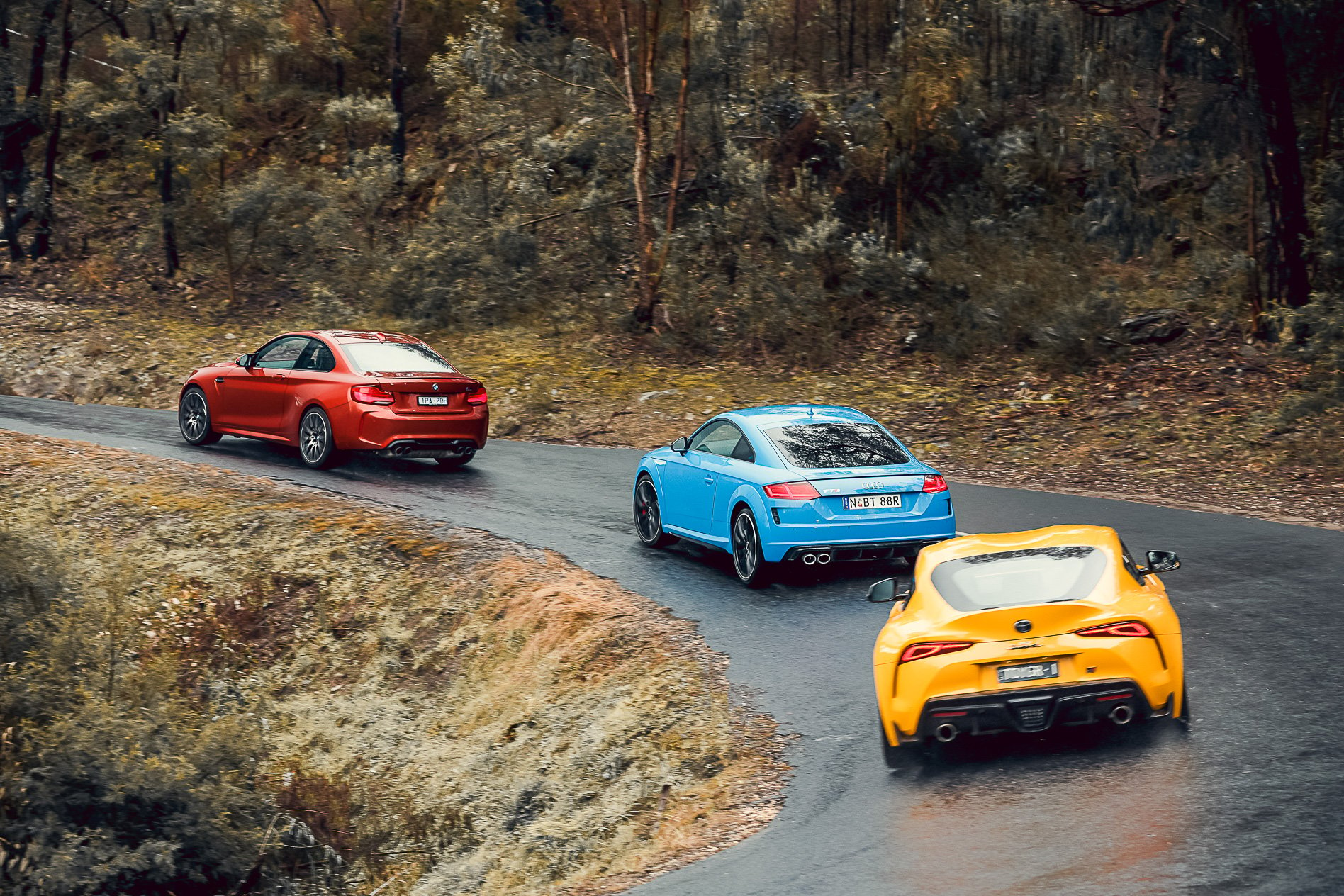Licola: 37°37’40.18”S, 146°37’25.13”E. Permanent population: 2. Distance from nearest Maccas: 96km. Grid power: none. Mobile signal: none. Well-sighted, traffic-free, 100km/h-posted corners: countless.
YOU THINK you know the Toyota Supra, don’t you? Its development story is well documented. You know that there’s a heavy dose of Munich in its DNA and that it reincarnates a badge many thought had gone for good. Its interminable gestation has dulled the sheen of its novelty, tempering the excitement of Toyota’s breathless early promise. Get behind the wheel of the Supra, however, and it might just be the most surprising thing you’ll drive this year.
It would be a pointless exercise comparing the $94,900 Supra GTS with a BMW Z4 M40i. Although the Supra shares most of its underpinnings with the BMW, the convertible Z4 is 30 percent more expensive and competes in an entirely different category. To properly test the Toyota’s mettle, we chose a far tougher assignment.
The BMW M2 Competition is a known quantity. It managed to see off the beguiling Alpine A110 in the Wheels May 2019 edition and would have won sister title MOTOR’s Performance Car of the Year crown had their guest judge not nobbled it with an outlier downvote. This Pure model is priced at $99,900, a mere $5K more than the Supra GTS, and represents a succulent stretch target.
Offering an alternative to the rear-drive six-cylinder formula is the freshly updated Audi TT S coupe. A turbocharged 2.0-litre four-pot driving all four wheels represents a layout that has been honed to a fine art, and while the TT might well attract the side-eye from purists, we were keen to see whether agility could beat brute force. We’ve never quite understood the fundamental disconnect between the near-universal affection for the Golf GTI as a driver’s car compared to the disdain for the mechanically similar TT S.
The latest iteration takes the excellent recipe of the Golf R and sharpens it still further with a stack more standard equipment, including a behemoth of a 680W 12-speaker Bang & Olufsen stereo. More power, less weight, better aero and superior rubber: it’s a tantalising offering and we had the first one in Australia. At $99,990 the least powerful car here goes nose to nose with the most potent.

THE 58KM ROAD from Glenmaggie to Licola becomes unexpectedly wild for Southern Victoria. Mobile phone coverage blinks out after 15km and, after a while, even the power grid vanishes. Licola’s the only privately owned village in Victoria and also the only one not connected to the state electricity grid. The road skirts the lake at Glenmaggie before climbing steadily, scribing the rim of a vast cirque before dropping into forest where it contorts and writhes like a couple of rutting taipans.
From there it rises and falls along the route of the Macalister River, at one point vertigo-inducing vistas down to the river and then skirting the white water of the September snow melt. Beyond Licola, there’s even a 10km sting in the tail as the road contours in a series of rhythmic twists across the rills of a steep hill before eventually turning to dirt. It’s near perfect for these cars.
Supra first. Your initial impression of the Toyota is one of cultured power take-up, slurred automatic gearshifts and creamy damping. It feels far more like a GT car than a pugnacious street racer and that will represent either a relief or a disappointment, depending on your requirements. We know that BMW’s M2 Competition has all the easygoing geniality of a foot-faulted Nick Kyrgios, so the suspicion is that the Supra could find itself overmatched by Garching’s finest.
Despite its mellifluous dynamic handshake, start pressing on and there’s clearly some steel to the Toyota’s resolve. The front end feels vacuumed to the bitumen on turn-in. Try harder. Still laser-guided to the apex.
Wait to pour power to the rears and even when you think it has every chance, the stability control system takes a particular umbrage to being acquainted with 500Nm and intervenes brusquely. Switch the car into Sport mode and you can start nudging it about on the throttle but the key to driving the Supra quickly is to introduce your inputs gradually.
Try to jink it into a corner and the weight transfers clumsily, making it feel cumbersome. Slow your hands and feel it settle and lean onto its outside rear Pilot Super Sport. Then tickle on the throttle and it’s possible to maintain its fierce turn-in speed through the middle phase of a corner and then burst out with a small but satisfying degree of yaw.
The steering represents a refreshing change to the way that many manufacturers attempt to disguise weight by adding neuroses to the front end. Likewise, the purposeful brakes reward a measured application. The supple ride means that the Supra can carry fearsome speed even on poor surfaces.

The eight-speed ZF auto is well calibrated and best left to its own devices. Try to shift by ear and the lack of top-end operatics means that you’re constantly trying to force inappropriate downshifts, the software denying your fruitless taps at the left-hand paddle.
The forthcoming manual transmission would be no quicker, but it would be fun to introduce a certain physicality into the Toyota’s DNA. It sounds fierce inside. There’s no bulkhead behind the driver, so all of the bass tones and crackles from the exhaust saturate the cabin, upshifts accompanied by a deep woofle.
It’s quick but the M2 Competition is quicker. Quicker, fiercer, more urgent, more everything, really. As accomplished as the Supra feels on roads like these, the M2 feels focused like a fully fledged M car versus the lite version. The razor-sharp dual-clutch ’box prefers you to bang home the shifts, the steering weights up more aggressively, the suspension bucks and patters on poor surfaces and the borderline-genius M Dynamic drive mode goads you into provoking the car into smoky slides.
Does that make it a better driver’s car than the Supra? That’s debatable. It certainly makes it a different one; more demanding, more hyperactive and more involving. Its S55 six-cylinder revs more cleanly than the BMW B58 in the Supra but despite a 50Nm peak torque advantage, it doesn’t feel significantly more muscular.
The Audi TT S is 40kW down on the Supra and a massive 92kW shy of the M2 Competition Pure. Logic would suggest that on these roads it would be exposed as a makeweight, a dilettante in this esteemed company. Yet even at full noise in the M2, it never managed to gap the TT S. Eventually it became amusing; this four-pot irritant that just wouldn’t let the other two conduct their serious head-to-head. Click the Drive Select switch over into Dynamic mode and it transforms into an eerily convincing facsimile of the five-cylinder 2.5-litre lump found in the TT RS. It’s uncanny.
The ride quality of the TT S has come in for some criticism but there’s an individual mode in the Drive Select system which allows you to set the adaptive dampers into their more comfortable setting and wick up the rest of the car’s responses. Thus configured, it corners flat and hard, the big 255/30 ZR20 Pirelli P Zeros finding plenty of purchase in the dry. The steering at first feels disappointingly light, but get used to the weighting and it’s a very high-quality electrically assisted set-up.
The Audi’s steering feels clean, despite the front wheels always being driven, and allows you to concentrate on the important job of positioning the front end. When you do overcook it and push the front into understeer, there’s enough early warning coming through the wheel rim to prompt you to trim the line a little.
The front end of the TT S turns in crisply, the four-cylinder engine making the nose latch onto a line far more adroitly than the weighty five-pot in the TT RS. In the wet, it’s an absolute weapon. Excite the balance by braking late, ride the split second of scrub and then just give the throttle the treatment as you sight the apex.
When the heavens opened, neither the BMW nor the Toyota stood a chance of hanging onto the Audi which would pivot the rear end neatly on the brakes, pointing the nose exactly where you want to go. The 338mm front brake discs lack the cooling required to stand up to some serious abuse. After one run down the hill into our test venue, the smoking brakes were registering over 300 degrees on an infra-red thermometer.

At the Heathcote drag strip, you could throw a hat over the three cars in the race to 100km/h. The BMW managed 4.4sec, the Audi 4.5sec and the Toyota 4.6sec. Given its power deficit, the TT S ran out of puff further down the strip, going through 400m in 13.2sec versus the 12.6sec of the Supra and 12.5sec of the M2 Competition.
Observations? The Toyota has a comically inept launch-control system which results in huge, flailing gouts of wheelspin and yaw. A flat-out launch-control run saw the car record 5.9sec to 100km/h. Never bother with it. The M2 did its best work with launch control engaged, but the most consistent performer was the TT S. In other words, we’d back the Audi every time in a race off the line.
The Audi’s cabin also found near-universal favour with the test team. We don’t need to wax lyrical here about Ingolstadt’s grasp of perceived quality, but recent updates to the TT S have seen it accumulate equipment that was previously the preserve of the options list. For 2020, the TT S now gets heated front seats, metallic paint, red brake calipers, Nappa upholstery and that myringa-mauling B&O sound system.
By comparison the Supra feels a little plain. The first time you jump in, you’ll look for the Toyota content and probably identify the steering wheel boss and rev counter. You’ll also likely be nursing a sore head as even the shorter members of the test team managed to clout their noggins getting into the slightly claustrophobic cabin.
The test car also suffered from a persistent rattle in the boot, and the body-coloured paint on display peeking round the Supra’s door cards would have had Ferdinand Piëch choking on his schnitzel.
Recompense comes with the best seats of the bunch and easily the coolest door mirror view, all pumped-up flanks and vents. On the subject of the latter, I’m not sure if we’ve ever encountered a car with more fake, blanked-off vents than the Supra. They’re everywhere and give the car a superficial appearance that its dynamic talents don’t deserve.
The M2 Competition is a familiar shape, replete with black exterior detailing and those curiously fussy multispoke alloys that, to this rheumy eye at least, don’t work as well as the deep-dished five-spoke wheels of the old vanilla M2. It’s a little ironic that the most conventional three-box silhouette houses the most authentically sporting car here, but when extended, the M2 Competition possesses a layer of talent beyond the others.

It’s a car that you feel you could grow with as a driver, and whatever skills you graduated to, you would feel confident that the BMW could respond in kind. The Supra never quite feels so multifaceted nor endowed with such a fathomless depth of know-how. Nevertheless, the fact remains that unless you’re driving it at ten-tenths, it often feels a friendlier, more pleasant thing to pedal than the M2.
The suppleness of the suspension, the butter-smooth transmission and inclusions like adaptive suspension, head-up display, adaptive cruise and power-adjustable seats can make the bare-bones M2 Pure feel a little overwrought.
Which leaves the Audi TT S. We wondered if it could be embarrassed in this company, but it more than held its own. With better brakes and slicker ride quality, it could have scored an upset but something has to come third. It emerges with significant credit. Easy to both underestimate and overlook, this might be Ingolstadt’s most convincing front-engined sports car.
Splitting the Toyota and the BMW isn’t easy because they feel so different, but Bavaria just squeaks Austria on this occasion. The M2 Competition has a layer of talent that sees it vying with the greatest M cars of all time.
Try as it might, the Supra can’t level with that depth of expertise. It delivers an alternative, compelling blend of dynamic qualities that are a credit to Tetsuya Tada and his engineering team. Park your prejudices about whether this is a Toyota or a BMW. It’s just an extremely good sports coupe. But, on this occasion at least, it has come up against something tinged with greatness.

Where’s the 718 Cayman?
Good question. We featured the cooking 718 Cayman coupe a couple of months back in our Porsche 992 test and, truth be told, it would have acquitted itself very well here.
Porsche wasn’t so confident. It suggested a 257kW 718 Cayman S might be better suited given the competition, but at $150,090 before options for a PDK-equipped car, we felt that this stretched the scope of the comparison a little too far. Still, nice try.






